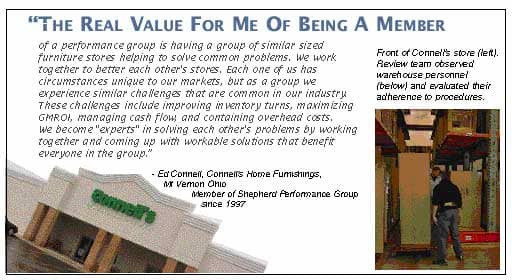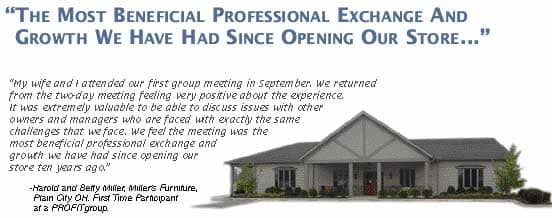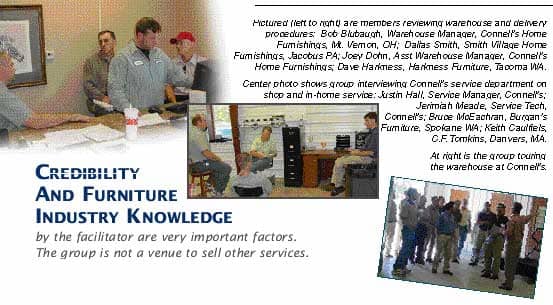Groups of similar, non-competing retailers are banding together to compare financial and operations information.
A major challenge faced by home furnishings retailers is the difficulty in fostering continuous improvement in the absence of access to useful comparative financial and operational data.
Retailers can discuss topics such as their state's workers comp rates and national topics like consumer bankruptcy issues with other firms at their local Chamber of Commerce. Accountants and lawyers can provide specific expertise. An advisory board or board of directors may provide insight. And there are general surveys that compile statistics on average GMROI, worker compensation and sales per square foot, for a broad cross section of store operations. There are, however, furniture retailing issues that require more specific information. Sometimes retail managers can benefit from sharing, information from stores of similar size that sell the same types of products and operate in business environments that share some common features.

A proven model for retail networking that has benefited furniture retailers has roots in the auto industry.
The auto industry called them “Twenty Groups.” Groups of similarly sized non-competing auto dealers that were geographically diverse would meet to compare financial and operating data. The purpose was to benchmark key indicators with the goal of learning best practices for mutual gain. Some were unsuccessful because they become focused on social aspects while others made great progress. The most successful ones included peer review, an on-site review process and capable facilitators to keep the program focused and on track. They are still very important in auto retailing. Ted Shepherd is credited with bringing the Twenty Group concept to furniture retailing about ten years ago with Shepherd Retail Performance.
Firms that provide these services to furniture retailing are, Shepherd Retail Performance, JRM Sales & Management, Inc., PROFITgroups by PROFITsystems, Inc. and Profitability Consulting Group in partnership with XSCEND. These companies as well as retail members were interviewed for this article, but confidential data was not shared with FURNITURE WORLD. Please also note that the application of this concept for improving retailer performance is our main focus and no specific provider will be recommended.

Each group has it's own self governing structure covering everything from maintaining confidentiality to acceptance of new or additional members, dismissing a member, etc. They decide on agendas, the price range of hotels and meals, outside speakers and other group meeting details. Each member is expected to participate so each contributes as well as receives value. Some groups are made up of owners and others are composed of sales manager groups, advertising manager groups, etc.
The balance sheet is the starting point for the meeting structure with statistical summaries exceeding 40 pages. The organization of the data is in a manner that shows individual participant values plus the averages for the top performers in the group. Using standard compilation techniques, values are converted to percentages of revenue for comparison. Frankly, there is a lot of preparation work to standardize the data in light of different financial reporting systems and business structures. Credibility and furniture industry knowledge by the facilitator are very important factors and the group is not a venue to sell other services.
Meetings may be held at or near a participant's location and the members split up into evaluation teams covering many areas of the business. The photos were taken during a meeting at Connell's Home Furnishings in Mount Vernon Ohio. The Shepherd Premier Performance Group met there in late September and did a fine comb review as well as the standard agenda. I observed the distribution center portion and was impressed with the thoroughness of the questions. Each team presents their observations and recommendations to the group for discussion. The shots are called as they see them with the goal of improvement.
Most groups have a requirement that retailers bring a “Single Best Idea” to each meeting. This is a great way to bring new ways of doing business to the table. Frequently the ideas are simple changes that make retail operations smoother without requiring large expenditures. For example, changing the receiving or bar code label color or label print color periodically makes old inventory stand out in walks through the warehouse.

Most retailers can improve their overall business by participating in an appropriate group. Long-standing professional relationships as well as friendships are developed which helps each company in their respective marketplaces.
For additional information...
JRM Sales & Management,
www.jrmsales-mgmt.com 678- 574-0937
Shepherd Retail Performance,
www.shepherdonline.com 770-541-2400
PROFITsystems, Inc.,
www.profitsystems.net 800-325-2018
Profitability Consulting Group,
www.furnitureprofits.com 919-732-9770
Contributing editor Dan Bolger of The Bolger Group helps companies achieve improved transportation, warehousing and logistics. You can send inquiries on any aspect of transportation, warehousing or logistics issues to Dan at dbolger@furninfo.com